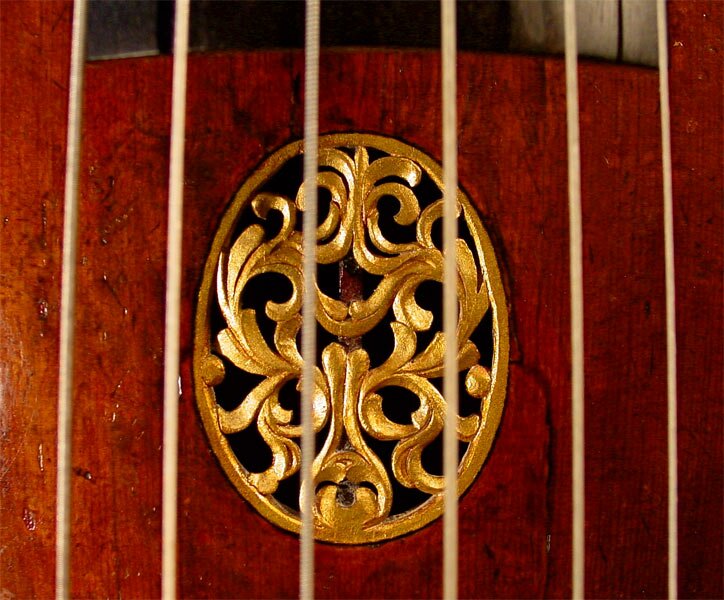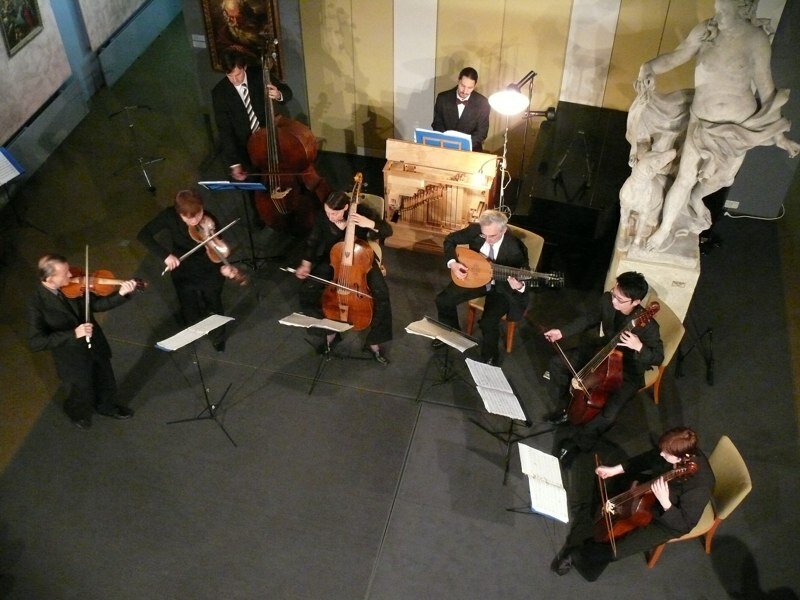Felix Austria
Music of the Austrian Imperial Court

Programme
| Heinrich Ignaz F. Biber (1644-1704) | Sonata II F-Major from “Fidicinium Sacroprofanum” |
| — | — |
| Giovanni Porsile (1680-1750) | “La bella ragione” from “L’anima immortale” (1722) |
| — | — |
| Johann Joseph Fux Sonate (1660-1741) |
Sonate (Kanon) in g-minor |
| — | — |
| Johann Joseph Fux (1660 – 1741) | “Sento nel cuore” from “La decima fattica d’Ercole” (1710) |
| — | — |
| Johann Schenck (1660 – after 1712) | Sonata in a-minor from “L’Echos du Danube” Adagio-Giga-Corrente-Adagio-Vivace |
| — | — |
| Attilio Ariosti (1666-1740) | “Prole tenera” from “La Profezia d’ Elise” |
| — | — |
| Georg Muffat (1653-1704) | Concerto XII “PropitiaSydera” (1701) Grave-Allegro-Aria-Gavotta-Ciacona |

Orpheon Consort
| José Vázquez – violin, viola da gamba, direction | |
| Christa Opriessnig – violin, viola da gamba | Christine Esser (Zürich) – soprano |
| Lúcia Krommer – viola da gamba | |
| Susanne Braumann – viola da gamba | Vít Bébar – harpsichord, organ |
| Kunihiro Mimura – viola da gamba | |
| Martin Hofinger – Violone | Matthias Otto – Theorbe |

Instrumentarium
Violin by Nicola Amati, Cremona, 1669
Violin by Matthias Albanus, Bolzano, ca. 1680
Treble viola da gamba, Paul Alletsee, Münich, ca. 1700
Treble viola da gamba by Giovanni Balla Bugger, Mantua, ca. 1630
Bass viola da gamba by Jakob Stainer, Absam, 1671
Bass viola da gamba by Johann Seelos, Linz, 1691
Bass viola da gamba by Nikolaus Leidolff, Vienna, 1695
Bass viola da gamba by Michael Albanus, Graz, 1706
Violone by Johann Georg Thir, Vienna, 1750
Harpsichord after Gio. Battista Giusti (1682)
Orgel positiv by Chinaglia, Milano
Texts to the vocal works
La bella ragione
La bella ragione / ristrett’è in prigione / del senso infidel.
Travia dalla Luce / che l’alma conduce / al porto del Ciel.
(Beautiful Reason lies emprisoned in the dungeon of inconstant senses.
She does not allow herself to be led by the Light, that leads the Soul to the Port of Heaven.)
Prole tenera
Prole tenera, cessa di piangere / che l’ira frangere non si può.
Lascia deh a me il lagrimar per te / che più di cor almen’ io piangerò.
(Tender child, cease to cry: no one can overcome fits of anger.
Leave it to me to shed tears for you: at least I will weep from the depths of my heart.)
(From the Old Testament , 2. Book of Kings, 6, which documents a regretable case of cannibalism – the eating of children – during the siege of Samaria and the famine that ensued.)
Sento nel cuore
Sento nel cuore / un dolce affanno / che sembra amore / e amore non è.
Quello ch’io sento / è un dolce inganno / che il cor diletta / ma con tormento / che l’alma alletta / senza mercè.
(I feel in my heart a sweet pain which appears to be love, but it is not. That which I feel is a sweet deception, that delights my heart, but brings pain with it, which entices my soul whithout pity.)
About the program
No one will leave this church without having acquired a deep respect for the musical uniqueness of Austria’s Baroque heritage of the 17th Century. Under the aegis of Leopold I, who was himself an able composer, the Arts – above all, music – reflected the brilliance and magnificence of the Habsburg Empire, which had just attained the pinnacle of its power. Culturally the Empire looked towards Italy, the cradle of the Baroque. Over 120 composers from all over Italy were employed in Austria at this time, including those on our programme. Local talents throve on the Italian legacy. Baroque, one should call to mind, is purely Italian phenomenon: Georg Muffat studied with Corelli in Rome; Biber’s violinistic exploits sprang from cisalpine models. The Imperial Collections, which harbours the majority of the works on our programme, preserve innumerable treasures from this period, which vouch for the high quality of musical life of the times.
About the music
With the separation of vocal from purely instrumental music, which took place in the 17th Century, arose the main forms of Baroque music: opera and oratorio, concerto, sonata and partita. The arias by Bononcini, Porsile, Fux and Ariosti are to be found among the sheer inexhaustible fundus of opera and oratorio of the Leopoldina Collection in the National Library in Vienna. Characteristic for the orchestration of the laments is the preferential employment of the viola da gamba, an instrument very much cultivated at court, because of its affinity to the nuances of the human voice. Giovanni Bononcini, a cellist, fruitful composer and cosmopolitan spirit, who later vied against Händel for the favour of the English public, produced numerous operas for the Viennese Court, including Il Ritorno di Giulio Cesare, from which this aria was drawn. The sensuous cantabile of the Neapolitan School is quite evident in the Arias by Porsile and Attilio Ariosti: the gracile melodic lines of the lamento Prole tenera offer an exquisite example of his art.
The work by the much-coveted composer and later maestro die capella of San Marco in Venice, Giovanni Legrenzi is conceived in the sonata da chiesa form. One may infer that this serious, profound sonata a quattro viole di gambe could have well served as an introduction to a tragic oratorio or music for lent. It was printed, however, in a collection of instrumental works dedicated to Leopold I, entitled La Cetra.
A sublime synthesis of Italian melodic writing and structured form on the one side, and German full-voiced sonority, on the other, obtain in the compositions of the violin and viola da gamba virtuoso, Heinrich Ignaz Franz Biber. Although he had full technical command of his instruments, indeed expanded the horizons of their possibilities through many innovations, Biber never employed this virtuosity as an end to itself, but rather in the service of music. His impeccable counterpoint, his dignified construction and his noble cantilene lay testimony of his irreproachable good taste. The sonata II comes from his collection entitled Fidicinium sacro profanum,
Johann Joseph Fux, from Styria, succeeded in asserting himself against the continuous assailments of the Italian Hegemony at the Austrian Court; he even achieved the position of Kapellmeister. Even outside of his treatise on counterpoint, Gradus ad Parnassum{, Fux delved into compositional games, as in this sonata for three violas da gamba, written as a canon for the two upper voices. From his Opera, Giulio Cesare, came this expressive and virtuoso aria: Sento nel cuore.
Recognised as the most important intermediary of performance practices from France and Italy to the North, Georg Muffat learned under Lully in Paris the French Style and under Corelli in Rome the Italian Style. The Concerto grosso, Propitia sidera appeared in the collection, Armonico Tributo. It ends with a breathtakingly beautiful chaconne. JV
Zum Programm
Niemand wird heute den Saal verlassen ohne eine hohe Achtung für die musikalische Einmaligkeit der österreichischen Barockkultur des 17. Jahrhunderts erworben zu haben. Unter der Obhut Leopold I – der selber ein gevifter Komponist war – spiegelten die Künste – allen voran die Musik – Glanz und Pracht des Habsburger Reiches wieder, das gerade den Gipfel seiner Macht erreichte. Kulturell stand das Reich aufs Engste mit Italien – der Wiege des Barock – in Verbindung. Über 120 Komponisten aus ganz Italien versahen ihre Dienste hierzulande, darunter auch diejenigen des heutigen Abends. Die einheimischen Talente hingegen zehrten vom italienischen Gedankengut . Barock, muß man sich vergegenwärtigen, ist schließlich ein rein italienisches Phänomen: Georg Muffat studierte bei Corelli in Rom; Bibers Geigenkunst entsprang seinen cisalpinischen Vorbildern. Die kaiserlichen Sammlungen (die Mehrzahl der Werke auf dem Programm befinden sich in der Nationalbibliothek enthalten unzählige Schätze aus dieser Zeit, die von der hohen Qualität des damaligen Musiklebens zeugen.
Über die Musik
Mit der Trennung der vokalen und der rein instrumentalen Musik, die sich im 17. Jahrhundert vollzog entstanden die Hauptformen der barocken Musik: Oper und Oratorio, Concerto, Sonate und Partita. Aus dem schier unerschöpflichen Bestand an Opern und Oratorien der Leopoldina Sammlung stammen die Arien von Porcile, Fux und Ariosti. Charakteristisch für die Deutung der Lamenti ist die Verwendung der Violen da gamba deren Spiel am Wiener Hof sehr gepflegt wurde weil diesem süßklagenden Instrument eine Ähnlichkeit mit der menschlichen Stimme nachgesagt wird. Dank seiner angeborenen Begabung vermochte sich der aus der Steiermarkt stammende Johann Joseph Fux gegen die allgegenwärtigen italienischen Musiker zu behaupten, denen bei den Bewerbungen um die lukrativen Stellen sowohl im Habsburg Reich wie auch überall sonst in Europa stets den Vorzug vor den Einheimischen gebeben worden ist. Schon unter Leopold I versah Fux zunächst als Hofkomposisteur seinen Dienst, bis er schließlich 1715 zum Kapellmeister befördert wurde.
Die sinnliche Kantabilität der Neapolitanischen Schule ist deutlich in den Werken des viel gereisten Viola d’ amore Virtuoso Attilio Ariosti zu spüren: die grazilen melodischen Linien des Lamento Prole tenera liefern ein exquisites Beispiel seiner Kunst. Sein jüngerer Landsmann, Giovanni Porsile gelangte über Spanien nach Wien, wo er bis zu seinem Tode wirkte. Porsile brachte den neuen bel canto Stil von Pergolesi und Scarlatti nach Österreich, der bald Europa erobern würde.
Bereits in Sonata da chiesa Form sind die zwei Werke des vielgefragten Meisters Giovanni Legrenzi, der schließlich die bedeutendste Stelle des Abendlandes: maestro di capella in San Marco bekleidete. Gewiß dienten diese zwei ernsten, tiefsinnigen sonate a quattro viole di gambe als Einleitungen zu Passionsmusiken oder tragischen Opern; erschienen sind sie jedoch in einer Kaiser Leopold I gewidmeten Sammlung instrumentaler Musik: “La Cetra”.
Eine erhabene Synthese italienischer Melodiebildung und strukturierter Form einerseits, deutscher vollstimmiger Klanglichkeit andererseits stellen die Kompositionen des Violin und Viola da gamba Virtuosen Heinrich Ignaz Franz Biber dar. Obwohl er die Technik seiner Instrumente vollkommen beherrschte gar ihre damaligen Grenzen durch viele Innovationen erweiterte setzte er diese Virtuosität nie als Selbstzweck, sondern stets im Dienste einer guten Musik ein. Sein ta-delloser Kontrapunkt, seine gediegene Faktur und edle Cantilene zeugen von einem ausgesprochen guten Geschmack.
Als wichtigster Vermittler der Aufführungspraktiken Frankreichs und Italiens im deutschen Raum galt der vorzügliche Komponist aus Elsaß Georg Muffat, der früh in Paris bei Lully, 1680-82 in Rom bei Corelli diese zwei verschiedenen Stilrichtungen von ihren bedeutendsten Vertretern aus erster Hand kennenlernte. Das Concerto Grosso Propitia sidera (Glückbringende Sterne) ließ er sogar vom römischen Meister selbst korrigieren, bevor er es in der Sammlung Armonico tributo herausgab. Daß er diese Concerti sehr ernst nahm gab sein Vorwort bekannt: nur eines darf an einem Konzert gespielt werden; man darf den Fluß des Ganzen niemals mit Stimmen oder sonstigem unterbrechen; wenn man unbedingt ein anderes Werk von ihm am gleichen Abend hören möchte, dann soll man schreibt Muffat eine leichte, unterhaltsame Suite im französischen Stil aus seiner Florilegia wählen. Abschluß des Concertos bildet die traumhaft schöne Ciaconna, die mit Tempowechseln durchsetzt ist. JV